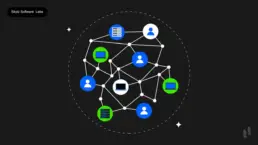The internet has come a long way since its inception in the 1960s. From basic text-based websites to interactive Web 2.0 platforms, the internet has become an integral part of our daily lives. But what comes next? Enter Web 3, the next evolution of the internet that promises to revolutionize the way we use the web.
Web 3.0 is the next version of the internet that will make it easier for computers to understand and use the information on the web. This will create a more open and scatter web that gives users more control over their data and privacy. Web 3 will use new technologies like blockchain to make the internet more secure and trustworthy, and to create new kinds of online experiences that are more personalized. Read More
“Web 3.0 will be a scatter internet, where data and services are no longer controlled by a single entity, but rather shared among users in a trustless, transparent manner.” – Andreas M. Antonopoulos
What Is Web 3.0 Technology?
Web 3.0 technology is like the next level of the internet. It’s being made to create a better web that’s more fair, safe, and easy to use. The goal is to give people more control over their own data and make it harder for big companies to control everything. Web 3.0 will also make it easier for different apps and websites to work together, and it will use smarter technology to understand what people want and help them find it faster. Overall, Web 3.0 is about making the internet work better for everyone, not just for a few big companies.
Key Features of Web 3.0
- Decentralization: Web 3.0 aims to reduce the dominance of large tech companies. and create a more decentralized web environment using blockchain technology. This will help to promote greater privacy, security, and control over user data.
- Interoperability: Web 3 aims to enable different systems and applications to work together seamlessly. This will allow for greater collaboration and innovation and will help to break down the silos that currently exist between different web platforms.
- Semantic web: Web 3 aims to make web content more easily understandable by machines, allowing for more intelligent and personalized searches and recommendations. This will make it easier for people to find the information they need and help to create a more personalized web experience.
- Artificial Intelligence (AI): Web 3 will leverage AI technologies to create more intelligent and automated interactions between users and the web. This will enable new ways of interacting with web content and will help to create more personalized and engaging experiences.
Overall, Web 3.0 is about creating a more decentralized, secure, and user-friendly web that empowers individuals and promotes greater collaboration and innovation.
Layers of Web 3.0
Web 3.0 is made up of different layers, each with its own purpose and functionality. Here’s an explanation of the different layers of Web 3 in simple language:
- Protocol layer: This is the foundation layer of Web 3, and it defines the rules and standards for communication between different systems and applications. The protocol layer includes technologies like blockchain, which provide a decentralized and secure way of exchanging information and transactions.
- Service layer: The service layer provides access to different services and resources on the web. This includes decentralized apps (dApps), which are built on top of the protocol layer and use blockchain technology to create new ways of interacting with the web.
- Semantic layer: The semantic layer is all about making web content more easily understandable by machines. This layer uses technologies like the semantic web, which allows machines to understand the meaning of data and information on the web.
- User interface layer: This is the layer that users interact with directly. It includes the different interfaces, tools, and applications that people use to access the web. The user interface layer aims to create a more user-friendly and engaging web experience, using technologies like AI and virtual reality.
Overall, the different layers of Web 3.0 work together to create a more decentralized, secure, and intelligent web environment that empowers individuals and promotes greater collaboration and innovation.

How Web 3.0 change our lives.
Web 3.0 has the potential to bring about significant changes in our lives. Here are some ways in which it could impact us:
- Greater control over personal data: With Web 3.0’s focus on decentralization and privacy, users will have greater control over their personal data. They will be able to decide what data they want to share and with whom, and have the ability to revoke access at any time. This will reduce the risk of data breaches and give users greater peace of mind about the security of their data.
- More secure and transparent transactions: Web 3.0’s use of blockchain technology will enable more secure and transparent transactions. This will reduce the risk of fraud and provide greater accountability in financial transactions. It will also reduce transaction costs and enable more efficient peer-to-peer transactions.
- Enhanced online experiences: Web 3.0’s use of artificial intelligence and the semantic web will enable more personalized and intelligent online experiences. For example, AI-powered chatbots could help users find information more easily, while personalized recommendations based on user preferences could enhance the overall online experience.
- Improved collaboration and innovation: Web 3.0’s emphasis on decentralization and interoperability could enable greater collaboration and innovation across different industries and platforms. It could create new opportunities for startups and entrepreneurs, and enable greater access to resources and information.
- New business models: Web 3.0’s focus on decentralized technologies could lead to new business models that challenge traditional centralized models. For example, decentralized marketplaces could enable peer-to-peer exchanges of goods and services, while decentralized finance (DeFi) could provide more accessible and transparent financial services.
Possible Key Applications of Web 3.0
Here are some key applications.
- Decentralized Finance: Web 3.0 enables the creation of decentralized financial applications. DeFi platforms offer a range of financial services, including lending, borrowing, and trading.
- Decentralized Social Networks: Web 3.0 makes it possible to create social networks that are decentralized. These networks can provide users with greater privacy, security, and control over their data.
- Decentralized Marketplaces: Web 3.0 enables the creation of decentralized marketplaces where buyers and sellers can transact directly with each other, without the need for intermediaries. This can lead to lower fees and greater transparency in transactions.
- Identity Management: Web 3.0 enables the creation of decentralized identity management systems, which can give users greater control over their personal data and protect them from identity theft and other forms of online fraud.
- Distributed Computing: Web 3.0 makes it possible to create decentralized computing systems, where computing power is distributed across a network of nodes. This can enable more efficient processing of large amounts of data and greater resilience against system failures.
- Digital Asset Management: Web 3.0 enables the creation of decentralized digital asset management systems, where ownership of digital assets can be tracked and transferred securely and transparently.
Overall, Web 3.0 is expected to enable a wide range of new applications and services that are decentralized, transparent, and secure.
So what are the benefits of Web 3? Here are some of the key advantages of this new era of the internet:
- Better search results: Web 3 uses semantic technologies to understand the meaning of data, resulting in more accurate and relevant search results. This means that users can find what they’re looking for more easily and quickly, making the web experience more efficient and productive.
- Improved user experience: Web 3 provides a more personalized and intuitive user experience. By analyzing a user’s behavior, interests, and preferences, Web 3.0 can deliver tailored content and recommendations, making the user experience more engaging and satisfying.
- Enhanced data integration: Web 3 allows for the integration of data from multiple sources, providing a more complete picture of a given topic. This means that users can access a wider range of information and insights, which can be particularly useful for research and analysis.
- More efficient data processing: Web 3 uses artificial intelligence and machine learning to process data more efficiently. This reduces the need for human intervention, making it easier to manage large volumes of data and perform complex tasks quickly and accurately.
- Better security and privacy: Web 3 incorporates better security measures to protect user data. This provides a more secure and private online experience, which is particularly important given the growing concerns around data privacy and security.
While Web 3 promises to bring significant benefits, it is not without its challenges. One of the biggest challenges is the complexity of the technology involved. Web 3 technologies are more complex and require more expertise to develop and implement, making it more difficult for small businesses and individuals to participate.
Another challenge is the lack of standardization. Web 3 is still in its early stages, and there is no standardized approach to implementing its technologies. This may lead to compatibility issues and fragmentation, which could slow down adoption.
Despite these challenges, Web 3 represents a significant step forward in the evolution of the internet. Its advanced technologies and features offer a range of benefits for users, including improved search results, a more personalized user experience, enhanced data integration, more efficient data processing, and better security and privacy. As Web 3.0 continues to develop and mature, we can expect to see even more exciting innovations and opportunities emerge.
I am text block. Click edit button to change this text. Lorem ipsum dolor sit amet, consectetur adipiscing elit. Ut elit tellus, luctus nec ullamcorper mattis, pulvinar dapibus leo.
we will discuss some of the disadvantages of Web 3.0.
- Complexity and cost: Web 3.0 technologies are more complex and require more expertise to develop and implement. This makes it more difficult for small businesses and individuals to participate. In addition, the implementation of Web 3.0 technologies can be costly, requiring significant investment in hardware, software, and training.
- Lack of standardization: Web 3.0 is still in its early stages, and there is no standardized approach to implementing its technologies. This may lead to compatibility issues and fragmentation, which could slow down adoption. This lack of standardization also makes it difficult for developers to create applications that work across different platforms.
- Privacy concerns: Web 3.0 technologies collect and analyze large amounts of data about users, which can lead to privacy concerns. As Web 3.0 continues to develop, there may be increased surveillance and tracking of user activity, which could raise ethical and legal issues.
- Limited adoption: Web 3.0 technologies are still in the early stages of development and adoption. While there are some early adopters, the technology has not yet reached mainstream adoption. This could limit the potential benefits of Web 3.0 and make it more difficult for businesses to justify investment in the technology.
- Potential for increased inequality: The complexity and cost of Web 3.0 technologies may lead to increased inequality. Small businesses and individuals may struggle to keep up with larger organizations that have more resources to invest in the technology. This could lead to a widening gap between those who have access to the benefits of Web 3.0 and those who do not.
In conclusion, while Web 3.0 promises to bring significant benefits, it is not without its challenges and drawbacks. The complexity and cost of the technology, lack of standardization, privacy concerns, limited adoption, and potential for increased inequality are all factors that need to be considered. As Web 3.0 continues to develop and mature, it will be important to address these challenges and find solutions that allow everyone to benefit from this exciting new era of the internet.
Related Posts
March 11, 2023
How much does it cost to develop a cryptocurrency exchange app like Binance?
Last year I wrote about why booking too far in advance can be dangerous for…
March 25, 2020
Top 5 tips to keep your IOS apps safe and secure
When you are alone for days or weeks at a time, you eventually become drawn to…
March 2, 2020
How much does it cost to build a domino-like pizza delivery app?
Online food ordering apps play an important role in our daily life, however,…







